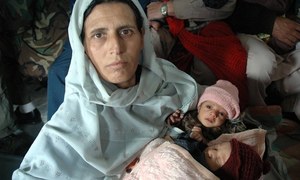 ISLAMABAD: The Global Nutrition Report 2017 launched on
Monday showed that 6pc children in Pakistan, mostly belonging to the
urban areas, are not only stunted but also facing obesity due to the
consumption of junk food.
ISLAMABAD: The Global Nutrition Report 2017 launched on
Monday showed that 6pc children in Pakistan, mostly belonging to the
urban areas, are not only stunted but also facing obesity due to the
consumption of junk food.
The report, launched by the
Planning Commission of Pakistan in collaboration with the United Nations
World Food Programme, also revealed that Pakistan’s spending on
nutrition — 3.7pc of the Gross Domestic Product (GDP) — was the lowest
in Asia.
On the other hand, Nepal was spending 13pc and Bangladesh 8pc of their GDP.
Aslam
Shaheen, the chief nutrition at the Planning Division, while presenting
the report said the world was faced with the burdens of three important
forms of malnutrition — childhood stunting, anaemia in women of
reproductive age and overweightness in adult women.
Global Nutrition Report 2017 says Pakistan’s spending on nutrition is lowest in Asia
About the internationally-agreed nutrition targets,
including Sustainable Development Goals (SDGs), he said no country was
on track to meet the targets to reduce anaemia among women of
reproductive age.
“Exclusive breastfeeding of infants
aged up to five months has marginally increased but the progress is too
slow. The most recent data about Pakistan shows that stunting prevalence
has increased slightly since 1992 to 2012 from 43pc to 45pc.
“However, exclusive breastfeeding rates have doubled from 1990 to 2013,” he said.
Mr
Shaheen said the rising rates of overweightness and obesity, 31pc among
women and 25pc among men, were of greater concern. The health sector
has a major role to play for nutrition specific interventions but it is
equally important to promote nutrition.
National Manager
for Pakistan Scaling up Nutrition (SUN) Movement Dr Irshad Danish told
Dawn that in Pakistan 70pc people cannot afford a balanced diet.
“Even
there is a disparity in provinces as in Punjab the percentage is 60pc
and in Balochistan it is 88pc. On the other hand, those who can afford a
balanced diet are not getting it because they consume junk food,” he
said.
Dr Danish said 40pc food was wasted in Pakistan but no one took steps to check it or create awareness about it.
“It
is a fact that if we spend one dollar on nutrition we will get the
benefit of 16 dollars because Pakistan has been losing $7.6 billion
every year because of the additional health expenditure and decreasing
productivity due to anaemia and other health issues,” he said.
Parliamentarians,
who were present at the report launching ceremony, pledged additional
budgetary allocations and legislative support to overcome malnutrition.
Speaker Sindh Assembly Shehla Raza said in her province people from Thar were severely suffering from malnutrition.
“The
government of Sindh is taking steps to address the issue but I believe
there is a need for legislation to stop early marriages and increase
birth spacing,” she said.
Speaker Balochistan Assembly
Raheela Hameed Khan Durrani said the provincial government was aware of
the issue of malnutrition and had taken several measures with support
from donors and development partners.
“I urge the
federal government to increase the financial resources for Balochistan
to address the challenges of malnutrition and food insecurity in the
province,” she said.
UN Resident Coordinator Neil Buhne
said: “Investing on health and nutrition of young children is one of the
best investments a country can make for its future prosperity.”
Acting
Country Director World Food Programme Katrien Ghoos said both short
term and long term solutions were critical and must be implemented to
have long-lasting impact on nutrition indicators in Pakistan.
Director
Nutrition Ministry of National Health Services Dr Baseer Khan Achakzai
claimed that political awareness of nutrition had grown in the country.
According
to the report, a vast majority of the world’s hungry and malnourished
lived in developing countries. Southern Asia faces the greatest hunger
burden with about 281 million undernourished people.